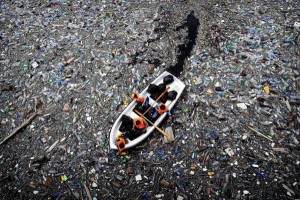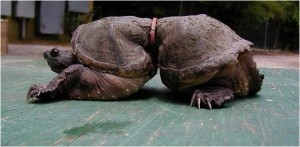The Great Pacific Garbage Patch 
Have you ever thought about where all of your garbage goes? We all know that most of it goes into the landfills in our local community, but does it all really go there? Do you really know? Imagine a landfill twice the size of some states in the United States filled with junk and trash, but now imagine that floating in the middle of the Pacific Ocean. I bet you’ve heard of it, the Great Pacific Garbage Patch is now heard about every where. This garbage patch lays in between California and Hawaii with a broad vortex of human waste like plastic bags, tires, cans, barrels, anything that you could through away into your garbage can end up in this vastly growing problem.
This patch is referred as the worlds largest garbage dump being twice the size of Texas. How big is that really? Estimates of size range from 270,000 sq miles (almost the size of Texas) or even to around 800,000 sq, which I think is out of proportion. The patch is characterized by exceptionally high relative concentrations of ocean plastics, chemical waste, and other debris that have been trapped by the currents of the North Pacific Gyre. The North Pacific Gyre is located in the northern Pacific Ocean, it is one of the 5 major ocean gyres. The gyre- a circular system of rotating ocean currents- has a clockwise circular pattern and is formed by for prevailing ocean currents. Despite of its tremendous size and density (4 particles per cubic meter), the patch is not visible from a satellite photograph.
One of the first questions I asked myself when I started my research was how could something so big even become that big? The patch formed gradually as the ocean currents pulled together all of the garbage. The garbage patch occupies a very large region of the Norther Pacific Ocean. Surface wind currents bring debris into the region and keeps it there, trapping it. 80% of the garbage comes from land base sources, while the other 20% comes from ships. Debris is generated on land at marinas, ports, revers, harbors, docks, and storm drains. Debris that comes from the ocean is from fishing vessels and cargo ships generally.
I’ve been talking about how big the Great Pacific Garbage Patch is and how it was formed, but what is the impact on the marine life. Even though the plastic debris is giving the insects places to lay their eggs, scientists are worried about the plastics that establish their main role for their habitat . This team recently went to research the wild life living around the garbage patch and found that nearly 10% of the fish living around that area had ingested plastic. Scientists that have studied the issue say that trawling the ocean for all of the trash would simply be impossible and would harm the marine life living there now as their habitat and environment. One of the most remote places on Earth, which is inhabited by a million Laysan albatrosses .
Over all of my research I have found out that the trash that is floating on the water isn’t even full garbage pieces, they are eroded and broken down into little pieces that look like confetti. There are many examples of trash from tooth brushes to unidentifiable pieces of plastic to what you threw out last night afloat in the one of five largest garbage patches. No scientist nor anyone has come up with an idea of getting rid of the collecting garbage afloat in the Pacific. My opinion is that I do not think we will ever be able to get all of the garbage out of the ocean, but we should try to help that. We do so much for our environment, but no one really advertises the ocean, no one says “Hey, why don’t we get rid of the garbage in the oceans?” And the main response is that it is to big and to much to get rid of, and that is because we have done that to our oceans and to our wild life. Try to remember until we cut off the trash and garbage flowing into the seas and oceans this patch will grow even bigger.
- Do you think that we can stop this problem?
- What do you think will happen if the garbage continues to grow?
- How long do you think we will let this problem go until we try to do something about it?
This topic was a very good idea to show how much the ocean is affected by garbage and litter. Its amazing to think the Great Pacific Garbage Patch is almost as big as Texas. I did some research on finding some ways to help stop or decrease this problem. The main thing we can do is to stop littering on beaches or near rivers or lakes. Most of the garbage is plastic bottles so they were all in our hands at one point or another. Here is a link to the website I found. http://news.nationalgeographic.com/news/2014/04/140414-ocean-garbage-patch-plastic-pacific-debris/
I haven’t heard about this before, but this was a really interesting article to read. It is crazy how much waste humans produce. It is becoming a big problem. The garbage pile is huge, and it is effecting the ecosystem around it. Also, I would like to say that this article was written very nicely, and I really enjoyed reading it. Well done. Here is a website on how the Great Pacific Garbage is effecting the ecosystem. http://www.onegreenplanet.org/environment/great-pacific-garbage-patch-is-destroying-the-oceans/
http://education.nationalgeographic.com/education/encyclopedia/great-pacific-garbage-patch/?ar_a=1
I think that this will continue to be a problem for a very long time. Since the garbage patch is so far away from any country’s coastline, nobody will take responsibility for it. Many people say any country that tries to clean up the patch will go bankrupt. This would also be extremely time consuming since the garbage patch covers such a large area. I think that it’s possible to prevent the patch from growing and becoming more of a problem, but I don’t think it will ever completely go away.
Its horrible to think that the cause to these animals death is due to our trash that we decided to put somewhere. Its terrible to think about how 10% of fish had ingested plastic. This website talks a little more about the situation. It says that about 80% of the trash in that area is from north America and Asia. Also Japan and Asia. It takes about one year for the trash to travel to the Great pacific garbage patch.
http://education.nationalgeographic.com/education/encyclopedia/great-pacific-garbage-patch/?ar_a=1
I have never heard of the Great Pacific garbage patch until reading this blog. It is terrible to think of all the marine animals who are affected by this. I think this problem could come to a stop if people recycled what could be recycled instead of just throwing everything out. Another way this could be stopped is by having cities around the country set up recycling programs for the communities so it is easier to recycle what could be getting recycled. If the garbage continue to grow in the ocean many marine animals could die and possibly go extinct because of the waste. From further research I found that this patch goes from North America to Japan and the ocean has a gyre system which is a circular ocean current formed by the Earth’s wind pattern which draws debris into the stable center of the current. http://education.nationalgeographic.com/education/encyclopedia/great-pacific-garbage-patch/?ar_a=1
The Great Pacific Garbage patch has many huge impacts on the world. One most peculiar example is how it is affecting our health. The plastic in the water can be consumed by fish mistaking them for prey. As this occurs fish eat each other and this cycle repeats its self and this results in fish that are higher on the food chain having higher concentrations on plastic in their bodies. If we eat this fish we could actually be eating plastic. If this cycle continues, then in a short amount of time fish on the top of the food chain may be to toxic for us to consume. For more information about how the plastics in the ocean affect our health go to: http://serc.carleton.edu/NAGTWorkshops/health/case_studies/plastics.html
This is a pretty sad topic. It’s horrible to think of how many animals die just because we are too lazy to find a better way to get rid of our crap. After a bit more research, I found out that the trash actually blocks sunlight from reaching algae and other autotrophs. That means a lot of them will die, and being that they are at the bottom of the food chain, the entire thing will be affected. And to make matters worse, we are talking about a collection of garbage the size of Texas, so it isn’t hard to tell that this thing can do a lot of damage.
http://education.nationalgeographic.com/education/encyclopedia/great-pacific-garbage-patch/?ar_a=1